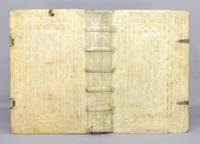HIEROGLYPHICA SIVE DE SACRIS AEGYPTIORVM LITERIS COMMENTARII . . . A CAELIO AUGUSTINO CURIONE DUOBUS LIBRIS AUCTI ET MULTIS IMAGINIBUS ILLUSTRATI by (BINDINGS - MONASTIC). VALERIANO, GIOVAN PIERIO - 1567
by (BINDINGS - MONASTIC). VALERIANO, GIOVAN PIERIO

HIEROGLYPHICA SIVE DE SACRIS AEGYPTIORVM LITERIS COMMENTARII . . . A CAELIO AUGUSTINO CURIONE DUOBUS LIBRIS AUCTI ET MULTIS IMAGINIBUS ILLUSTRATI
by (BINDINGS - MONASTIC). VALERIANO, GIOVAN PIERIO
- Used
Basileae: Per Thomam Guarinum, 1567. Second Edition. 362 x 235 mm. (14 1/4 x 9 1/4"). 6 p.l., 15, [1] pp., 15-441, [25] leaves. Excellent contemporary blind-stamped pigskin, covers with multiple frames of palmettes, rosettes, floral rolls, and an allegorical roll depicting Fides, Justitia, Caritas, and Spes; raised bands, traces of ink titling to spine, intact original brass clasps, small hole at head of rear board where a chain was once attached. Woodcut printer's device on title and last page, frontispiece portrait, 12 charts in the text, and 265 MOSTLY EMBLEMATIC ILLUSTRATIONS in the text. Front pastedown with (18th century?) engraved armorial bookplate and 19th century woodcut bookplate of William Schott; title page with two early (probably 17th century) inscriptions from the monastery library at Kaisersheim. Praz, p. 521; Caillet 10978; Adams V-51. Very minor soiling to pigskin, small area of discoloration at top of back board (where chain hasp had been located), front hinge beginning to open at the top, final few leaves with faint traces of mildew, barely perceptible diagonal dampstain at upper corner on a number of text leaves, other trivial imperfections, but a nearly fine contemporary copy, the unrestored binding showing almost no signs of use, and the text bright, clean, fresh, and with very spacious margins. This is a well-preserved copy of a curious compendium of ancient and Medieval lore that was once anchored in a monastic library. First published in 1556, it is the work of Valeriano (1477-1558), a native of Belluno, whom Pope Leo X de Medici made the educator of the younger generation of the Medici family. Valeriano rose to such fame as a scholar that Venice erected a statue of him outside the Frari church. Despite its title, this work will tell the reader very little about the hieroglyphs of Egypt, but it is full of information on natural history, culled from Medieval bestiaries, lapidaries, and the "Physiologus," an ancient book of Alexandrian origin. More important, the work was widely used as a source in the 16th and 17th centuries for art, literature, and emblem books. Mortimer calls the book "a major contribution to emblem literature," and Moseley calls it "the great encyclopedia of symbol for the period." The author arranges his information in a series of entries, each illustrating a "hieroglyph," accompanied by woodcuts ranging from an eagle with young to a sailing ship, to mystic triangles, to a man in a brimmed hat. Our second edition is enlarged with 20 additional woodcuts, and with two books written by Celio Agostino Curione as a supplement to Valeriano's work. This volume was once in the library of the Imperial Abbey of Kaisersheim ("Caesarea" in Latin), a Cistercian monastery in the diocese of Augsburg, and its attractive blindstamped binding may have been executed for that abbey. Its Fides roll (identified in the German bindings database as EBDB r003201) seems to be identical to one used by Daniel Wachtler, also called the Werdenstein Binder, known to have been active in Augsburg ca. 1578. In recognition of its value as a reference tool, our volume had been clearly designated by its 16th century keepers as a non-circulating book, having been chained to a rod to prevent its removal.
-
Bookseller
Phillip J. Pirages Fine Books and Medieval Manuscripts
(US)
- Book Condition Used
- Quantity Available 1
- Edition Second Edition
- Publisher Per Thomam Guarinum
- Place of Publication Basileae
- Date Published 1567